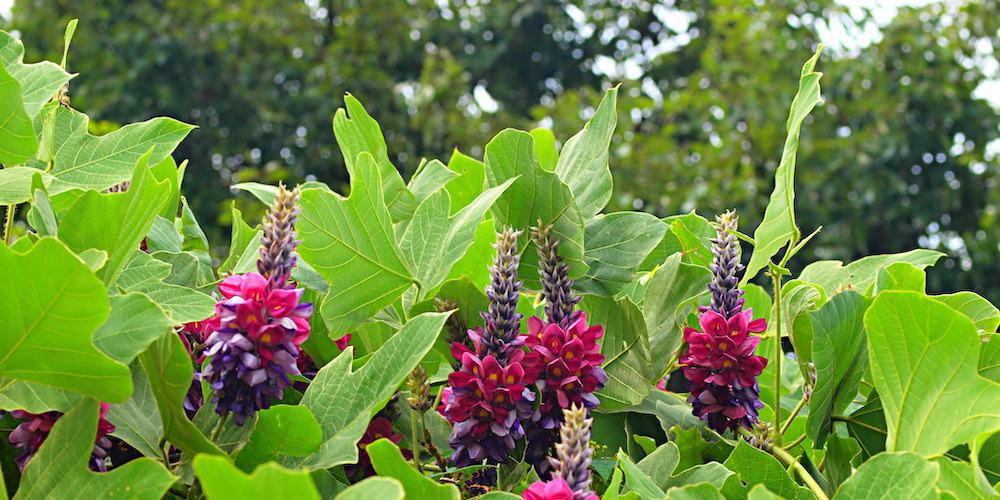VALIDATION SCIENTIFIQUE
Laure Fourchaud – 24.11.2021
Dr en physiologie de la nutrition
BENEFITS
✓ Helps fight addictions
✓ Anti-inflammatory
✓ Helps reduce the risk of cardiovascular disease
✓ May relieve hangovers
What is kudzu (or kuzu)?
Kudzu (Pueraria montana) is a plant in the Fabaceae family. This family is interesting for our diet since it includes legumes — including soy, broad beans, lentils, and beans. As for kudzu, it is the root that can be consumed, in the form of starch.
It is native to the Far East: it is primarily found to the east of China and Russia, in Korea and in Japan. It is an invasive, climbing plant: it can cover trees up to thirty meters tall, and can grow up to 30 cm per day! It produces clusters of small purple flowers.
Its stems are similar to grapevines, which has earned it the nickname \”Japanese vine\” and allows its vines to attach to trees or houses. It is found on various soils, at forest edges, in abandoned fields or by the roadside.

In Asia, kudzu has been used since the 3rd century BC in traditional Chinese medicine because it relieves fever, diarrhea or vomiting. A study from 1998 published by Harvard Medical School, Kudzu root: ancient Chinese source of modern antipsotropic agents, establishes its use to detoxify the body after excessive alcohol consumption beginning in the 7th century AD.
As a result, many researchers have studied the benefits traditionally attributed to it. Its effectiveness in combating alcoholism has been demonstrated by several studies.
It is also increasingly used to quit smoking and to address sugar addiction, although its inhibitory effects are not proven in those contexts.
Its lack of side effects compared to a synthetic drug makes kudzu a natural option for addressing all kinds of moderate addictions. It is already used in some treatments to support individuals in alcohol withdrawal and withdrawal from other substances.
Locally, it is available as a powder for cooking or as capsules used as a dietary supplement. In Japan it is the basis of many soups and desserts!
Nutritional composition
- Protéines
- Minéraux : calcium, phosphore, sodium et fer
- Flavonoïdes : isoflavones (dont puérarine, daidzine, daidzéine et génistéine)
- Béta-sitostérol
- Saponosides

Benefits
🍻 Helps fight addictions
Kudzu helps fight addictions, particularly to tobacco, alcohol, and sugar, and it may be this property that draws the most interest. For now, only its effect on alcohol consumption has been scientifically proven. But its impact on smoking and excessive sugar consumption is under study.
This study, conducted by Harvard University on men and women considered “heavy drinkers”, is the most significant. The researchers asked subjects to drink their preferred beer. Those on a kudzu regimen spontaneously drank less alcohol, drank more slowly, and took smaller sips than those on placebo.
This more recent study, also conducted by Harvard University, again demonstrated that puerarin contained in kudzu roots can reduce alcohol consumption in humans.
🌵 Anti-inflammatory
Kudzu contains active substances with anti-inflammatory properties. It is also one of the reasons it is prescribed in traditional Chinese medicine, such as turmeric.
Underlying these properties are the isoflavones it contains, notably daidzein and puerarin. These active compounds act as inhibitors of the body’s inflammatory responses.
Also read These tasty natural anti-inflammatory foods
Indeed, puerarin improves certain types of skin inflammations such as eczema. It blocks the secretion of pro-inflammatory cytokines – mediators that activate the inflammatory response.
This study conducted in mice and in vitro by the School of Medicine at Chonbuk National University in Jeonju, Korea, showed that taking kudzu improves lesions and reduces skin inflammation caused by eczema.
This study, conducted by the Korea Institute of Oriental Medicine in Daejeon, demonstrated in vitro the anti-inflammatory activity of certain kudzu components.
❤️ Reduces the risk of cardiovascular disease
Traditional Chinese medicine praises its positive effects on the heart. Indeed, kudzu helps reduce the risk of cardiovascular disease and protect the arteries.
It improves the cardiovascular system and protects the heart, notably by contributing to the reduction of bad cholesterol.
This study conducted by the University of Alabama in the United States on rats showed that a course of kudzu root extract lowers blood pressure and levels of bad cholesterol, thereby protecting cardiovascular function.
🍭 Regulates blood sugar
Kudzu is also known to help regulate blood glucose levels.
Again, it is puerarin that is believed to be responsible for this property. It increases glucose tolerance by lowering blood sugar and by increasing the storage of glucose as glycogen.
Furthermore, its anti-addiction effects could help reduce our excessive sugar consumption.
💆♀️ May relieve hangovers
Kudzu may also be an ally in relieving hangovers! As we have seen, traditional Chinese medicine has used it since the 7th century to detoxify the body after excessive alcohol consumption. It is still recommended today for this purpose.
The saponins it contains are thought to be responsible for this property, by supporting liver function and promoting liver detoxification, similar to aloe vera, which is also known for its detoxifying properties.
Thus, combined with other plants, it is part of many herbal teas meant to reduce hangover symptoms. But its effectiveness in this context has not yet been scientifically demonstrated.

How to consume it
Powdered roots
As we have seen, it is mainly the root that is used for therapeutic purposes. It is consumed as a powder. The powder is obtained by grinding the roots and extracting the starch they contain to produce food starch.
In general, it takes 1 kg of roots to obtain 100 g of kudzu powder. If it is used in dishes and desserts, it can also be consumed as an infusion in water or plant-based milk.
Kudzu can be found in organic stores, health food shops, and herbalist shops, as well as on online retailers specializing in nutrition and phytotherapy.

In capsules
There are many kudzu-based dietary supplements in capsule form. When taking them, check that they do contain puerarin, the main active ingredient, and daidzin.
Often, manufacturers indicate the percentage of active compounds. The less scrupulous even label the capsules “smoking cessation”… As a reminder, research has not yet demonstrated this property!
Cooking kudzu

In Japan, kudzu is not a dietary supplement, it’s used in cooking! Its leaves are prepared in salads and its flowers are made into tempura (fritters). Its roots are used as a culinary thickener, a bit like agar-agar: in powder form, they are mixed into various dishes. Because it doesn’t have much flavor, it can easily be incorporated into all kinds of recipes.
When using it as a culinary thickener, it is preferred in powder form. Add two teaspoons of it per cup of the liquid to be thickened or bound – a sauce or a soup, for example – and heat over medium heat to activate its gelling properties.
You can also use it to make gelatinous Japanese pastries, such as Kudzu mochi, to which you could even add matcha, another Japanese superfood!

Dosage
⏳ The dosage of kudzu varies depending on how it is consumed. In any case, it is recommended to start with three-month courses to assess its effects on the body.
💊 In capsules: you can go up to 1800 mg of dry extract standardized to 40% isoflavones
🥄 In powder form: 1 teaspoon per cup, two to four times a day
Contraindications, dangers and side effects
Kudzu poses no danger at recommended doses and no side effects have been observed when it is consumed orally.
However, its concentration of isoflavones, whose action can interfere with hormones, means that it is not recommended in cases of breast cancer, ovarian cysts, and endocrine disorders.
History, cultivation and market
Kudzu, as we have seen, has been used for therapeutic purposes in Asia for more than 2,000 years. In Japan, a tisane called kuzuyu was made from kudzu powder. In traditional Chinese medicine, a drink called Gěgēntāng, “kudzu root soup”, was prepared, containing its dried roots as well as ginger, cinnamon and other medicinal plants.
It was introduced to Europe in the 19th century and to the United States at the 1876 World’s Fair. Until the 1950s, American farmers used it to combat soil erosion, especially in the southern part of the country.
But kudzu was quickly labeled an “invasive plant”. Today, its spread is estimated at 30,000 m2 of land in the United States. It smothers other plants under a blanket of leaves, and in some cases even manages to uproot trees. In the United States, kudzu is nicknamed “the vine that ate the South”, in reference to its invasive capacity. Its growth rate, especially in summer, means it can rapidly turn an ecosystem into a monoculture.
Detailed nutritional values
This data has been compiled and verified for Darwin Nutrition by Laure Fourchaud, Ph.D. in nutritional physiology.
| Kudzu (powder) | /100g | %DV* | /5g (1cc) | %DV |
| Energy (kcal) | 347 | 17.35 | 17.35 | 0.867 |
| Fiber (g) | ||||
| Water (g) | ||||
| Macronutrients | ||||
| Protein (g) | 0,22 | 0.44 | 0,011 | 0,022 |
| Carbohydrates (g) | 83 | 32 | 4,15 | 1,59 |
| Of which sugars (g) | ||||
| Fats (g) | 0.22 | 0,31 | 0,01 | 0,01 |
| Minerals | ||||
| Calcium (mg) | 19,8 | 2,47 | 0,99 | 0,12 |
| Iron (mg) | 2,2 | 15,71 | 0,11 | 0,8 |
| Copper (mg) | 0,02 | 2 | 0,001 | 0,1 |
| Magnesium (mg) | 3,3 | 0,88 | 0,16 | 0,04 |
| Manganese (mg) | 0,02 | 1 | 0,001 | 0,05 |
| Phosphorus (mg) | 13,2 | 1,88 | 0,66 | 0,09 |
| Potassium (mg) | 2,2 | 0,11 | 0,11 | 0,005 |
| Sodium (mg) | 2,2 | 0,08 | 0,11 | 0,004 |
| Salt (g) | ||||
| Zinc (mg) | — | — | — | — |
| Vitamins | ||||
| Vitamin A (mg) | — | — | — | — |
| Vitamin C (mg) | — | — | — | — |
| Vitamin E (mg) | — | — | — | — |
| Vitamin B1 (mg) | — | — | — | — |
| Vitamin B2 (mg) | — | — | — | — |
| Vitamin B3 (mg) | — | — | — | — |
| Vitamin B5 (mg) | — | — | — | — |
| Vitamin B6 (mg) | — | — | — | — |
| Vitamin B9 or folate (µg) | — | — | — | — |
| Vitamin K (μg) | — | — | — | — |
*%AR : % Reference intake for an adult
Antioxidants: flavonoids (isoflavones: puerarin, daidzein and genistein)
Other compounds: coumarin, sterols (beta-sitosterol), saponins, glucosides (puerosides A and B)
Sources and scientific studies
Keung, W.M., Vallee, B.L., 1998. Kudzu root: an ancient Chinese source of modern antidipsotropic agents. Phytochemistry 47, 499–506.
Pieters, A.J., 1932. Kudzu a Forage Crop for the Southeast. United States Department of Agriculture, Leaflet, p. 91, p. 8.
Lukas SE, Penetar D, Berko J, Vicens L, Palmer C, Mallya G, Macklin EA, Lee DY, 2005. An extract of the Chinese herbal root kudzu reduces alcohol drinking by heavy drinkers in a naturalistic setting.
Penetar DM, Toto LH, Farmer SL, Lee DY, Ma Z, Liu Y, Lukas SE, 2012. The isoflavone puerarin reduces alcohol intake in heavy drinkers: a pilot study.
Lee JH, Jeon YD, Lee YM, Kim DK, 2018. The suppressive effect of puerarin on atopic dermatitis-like skin lesions through regulation of inflammatory mediators in vitro and in vivo.
Jin SE, Son YK, Min BS, Jung HA, Choi JS, 2012. Anti-inflammatory and antioxidant activities of constituents isolated from Pueraria lobata roots.
Ning Peng, Jeevan K. Prasain, Yanying Dai, Ray Moore, Alireza Arabshahi, Stephen Barnes, Scott Carlson, and J. Michael Wyss, 2009. Chronic dietary Kudzu Isoflavones Improve Components of Metabolic Syndrome in Stroke-prone Spontaneously Hypertensive Rats.



